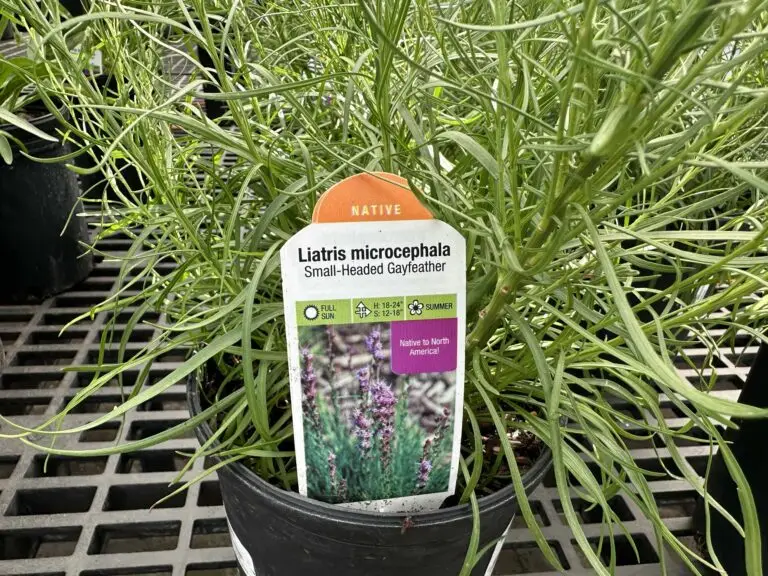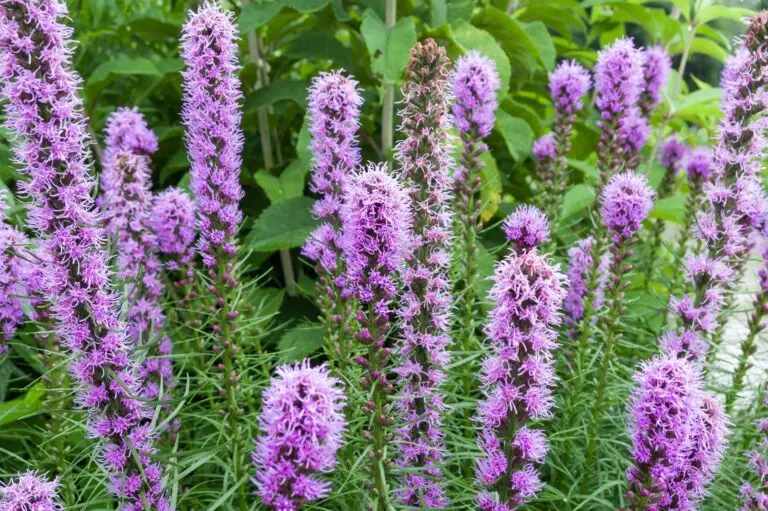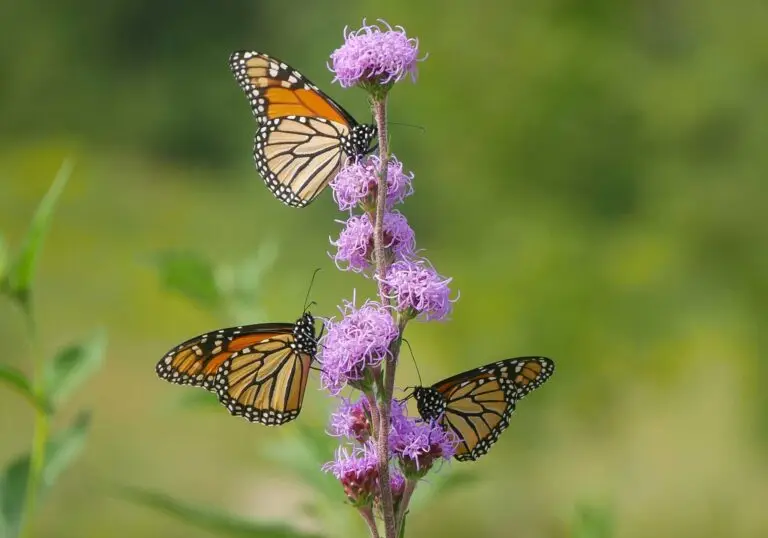Its name says it all. Blazing Stars send up a tall stalk in the spring and then cover it with tiny purple flowers throughout the summer. It looks like a living firework. Leave them alone in the fall and winter when their stalks are covered in seeds and they will turn into bird feeders. Since they are perennials, you plant them once and enjoy them for years. Blazing Stars are easy to grow, prefer sunny spots, and are drought-tolerant. Scroll on for planting tips.
- Full Sun, Part Sun
- Height depends on species
- Summer flowers
- Easy to find
Blazing Stars: a gorgeous pollinator buffet
Dig Deeper
Explore the history, types, and where to plant Blazing Star
Table of Contents
The common name Blazing Star is shared by roughly forty plants within the Liatris genus. All these plants have a few things in common: they all send up spikes, cover them with flowers, and come back year after year (making them perennials.) In this article, we’ll explore the benefits of planting Blazing Stars, highlight a few notable species, and recommend where to find Blazing Star seeds or plants for your garden.
Let’s start with a basic question:
What are the benefits of planting Blazing Star?
Plants native to North America—like Blazing Star—have grown in their home area for thousands of years. Their DNA knows the seasons, weather, and timing of your home area better than any other plants on the planet. They are excellent for our gardens for many reasons, including:
- Wildlife support (and sightings): Native plants are the food and habitat that birds, butterflies, and pollinators depend on to survive
- Save water and time: Native plants let you be a lazy gardener (all they need is rain once they are established)
- Fuss-free beauty: Native plants are resilient and beautiful (wander through our native plant library for proof)
Besides these native plant benefits, a few other landscaping benefits come when planting Blazing Stars:
Almost all Blazing Stars are tall native flowers
Blazing Stars (Liatris) are not shy native plants. Most Blazing Star species can grow up to 3-5 feet high when thriving. You have to appreciate its commitment to being pollinated! Each plant puts out a beautiful buffet line for the pollinators. Their long flower-filled stem gives multiple butterflies a place to snack alongside each other.

Blazing Stars flower from the top-down
Unlike hundreds of other flowering plants, Blazing Stars flowers from the top to the bottom. The plant will send up a tall stalk first, then buds will form along 3/4 of the stalk, and then slowly, the flowers will bloom from the top down.
It’s a beautiful show that lasts for weeks throughout the summer.
Now that we’ve covered some of what makes Blazing Stars unique, let’s meet a few native species for your garden.
Types of native Blazing Star
Here are some native varieties of Blazing Star perfect for sunny gardens.

Appalachian Blazing Star
Liatris microcephala
These are a short Blazing Star option, growing between 8-24 inches. Each delicate stalk is covered with tiny purple flowers. As you can guess from the name, these flowers are native to the Appalachian mountain region.

Cylindrical Blazing Star
Liatris cylindracea
Cylindrical Blazing Stars are shorter native options (only 8-24 inches!) Their button-like flowers are paired with an elegant stalk feathered in delicate leaves. Cylindrical Blazing Stars are native to the Midwestern US.

Dense Blazing Star
Liatris spicata
Dense Blazing Stars look like garden light sabers. Their stalks are covered in dense flowers that bloom from the top down. They can be tall: 2-5 feet. Dense Blazing Stars are native to the entire eastern half of the country.

Rocky Mountain Blazing Star
Liatris ligulistylis
Rocky Mountain and Rough Blazing Stars (below) look very similar, with one notable difference: Rocky Mountain prefers wetter soils, while Rough prefers drier sites. Both offer bright pom-pom-like flowers on tall stalks. Rocky Mountain is native to… (no surprise) the western and Midwestern United States.

Rough Blazing Star
Liatris aspera
Rough Blazing Stars arrange their blooms in pom-pom-like blossoms. Like all Blazing Stars, they are very drought tolerant. They can also be tall: 2-5 feet! Rough Blazing Stars are native to the Midwestern US.
Looking for the other 30+ species?
Wikipedia lists dozens more Blazing Stars within the Liatris family. A note: most other species can be difficult to find at native plant nurseries or online sources. There are just some plants that are not normally found in the commercial plant trade, especially when it comes to native plants.
Once you’ve found some seeds or plants, Blazing Star is super easy to grow.
How to grow Blazing Star
Blazing Star is very easy to grow and exceptionally easy to keep alive year-after-year. Blazing stars are:
- Low maintenance: no fertilizer or special needs are required for blazing stars to thrive
- Drought-tolerant: blazing stars can withstand dry, hot periods
- Longtime bloomers: their flowers are often open from June to August!
- Perennials: they will come back year after year. Once you plant them and they are happily established, you can enjoy them in your yard for years to come.

No pesticides or herbicides
Avoid using pesticides or herbicides near Blazing Star plants, as they can harm the butterflies and pollinators that visit the plant.
Plant Blazing Star in groups for maximum garden drama
Blazing Stars look best when they are planted in groups of 5 plants or more. Seeing such an ornate, showy display makes everyone look twice. It also helps pollinators and birds find food easily.
Blazing Star is deer-proof
Deer do NOT eat Blazing Star. If you’re worried about deer nibbling your garden, planting Blazing Star is good native gardening choice.

Grow Blazing Star from seeds
Growing Blazing Star from seeds is cheaper but takes some patience: plants will normally not flower until the second or third year. (Plants started by seed in the spring will not flower until the following summer or second-following summer.)
Blazing Stars take a while to grow from seed because the plant starts by putting its energy into developing a deep root called a corm. This long root takes the first year to grow, and it is also what helps Blazing Stars be very drought tolerant. The long root can reach down deep to find water, which it then stores in the root. Think of it like a camel hump that’s a root!
Here are some online nurseries that sell Blazing Star seeds:
- Everwilde Nursery sells many species of Blazing Star (seed packets start at $3.75)
- Hudson River Seed Company sells Dense Blazing Star seeds in beautiful seed packets ($4.49 for 200 seeds)
Grow Blazing Star from plants
Blazing Star plants will normally flower the first year they are planted and will return in the following years with stronger plants and bigger blooms. There are a few reliable ways to find Blazing Star plants for your yard:
Where can I find seeds and plants?
Finding native plants can be challenging (we partly blame Marie Antoinette.) To make it easier, we’ve assembled four sourcing ideas.
Native Nursery List
100+ native nurseries makes finding one a breeze
Online Native Plant Sellers
We've included 100+ online resources to help
Society Plant Sales
Every state has a native plant society; find yours
Online Communities
Local Facebook groups are a great plant source

What to plant with Blazing Star
Don’t forget: most Blazing Stars are tall. Put medium-height and short-height plants in front of tall species of Blazing Stars, otherwise, they will block shorter plants.
A great way to plan a garden is to ensure something is always flowering, from spring to fall. Here are some gorgeous, seasonal Blazing Stars pairings:
Native plants for the spring
other native plants for the summer
Native plants for the fall
Growing Blazing Star in your garden is a sure way to add a pop of color and support local butterflies and songbirds. With its striking flowers and pollinator-attracting qualities, this native plant is a great addition to any garden. Whether you’re looking to plant in a small backyard or a large prairie, Blazing Star is a hardy and reliable choice that will provide benefits for years to come. Happy planting!
Explore native plants by region
Sources
- Britannica, T. Editors of Encyclopaedia. “Liatris.” Encyclopedia Britannica, May 13, 2009. https://www.britannica.com/plant/Liatris.
- Nelson, Gil. Best Native Plants for Southern Gardens: A Handbook for Gardeners, Homeowners, and Professionals, (2010).
- Harstad, Carolyn. Go Native! Gardening with Native Plants and Wildflowers in the Lower Midwest. (1999), 209-210.
- North Carolina State University Extension. “Liatris microcephala.” NC State Extension Plants. https://plants.ces.ncsu.edu/plants/liatris-microcephala/
- New Moon Nursery. “Liatris ligulistylis.” New Moon Nursery. https://www.newmoonnursery.com/plant/Liatris-ligulistylis
Lady Bird Johnson Wildflower Center. “Liatris ligulistylis (Meadow Blazing Star).” Native Plant Database. https://www.wildflower.org/plants/result.php?id_plant=LILI

